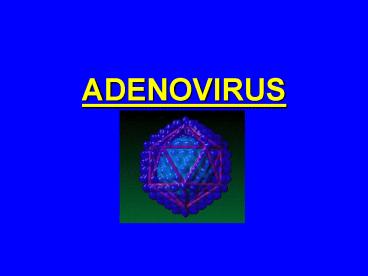ADENOVIRUS - PowerPoint PPT Presentation
1 / 49
Title:
ADENOVIRUS
Description:
swimming pool users, hospitals, residential institutions, day care settings ... Contaminated water in swimming pools, fomites. Adenoviral Infections of the eye ... – PowerPoint PPT presentation
Number of Views:2569
Avg rating:3.0/5.0
Title: ADENOVIRUS
1
ADENOVIRUS
2
ADENOVIRUS
- DNA viruses first isolated from adenoidal tissue
in 1953
3
ADENOVIRUS
- Family Adenoviridae
- Genus Mastadenovirus
4
Transmission electron micrograph of adenovirus
Source- PHIL, CDC
5
ADENOVIRUS - Classification
- Subdivided into 6 subgroups based on
- hemagglutination (A-F)
- Human pathogens belong to 49 serotypes
- Common serotypes- 1-8, 11, 21, 35, 37, 40
- Enteric Adenoviruses belong to subgroup F
6
ADENOVIRUS - Structure
- Non-enveloped DNA virus
- 70-90 nm in size
- Linear ds DNA genome with core proteins
7
ADENOVIRUS EM APPEARANCE
8
ADENOVIRUS - Ultrastructure
- Icosahedral capsid with 252 capsomeres
- (12 pentons at vertices and 240 hexons)
- Each penton has a fibers with terminal knob
projecting from it
9
Adenovirus- 3 D structure
10
Adenovirus - EM appearanceNote- projecting
fibers and terminal knob
11
ADENOVIRUS-Ultrastructure
12
ADENOVIRUS STRUCTURE
13
Structure
14
Pathogenesis and Replication
- Infects mucoepithelial cells of respiratory, GI
and GU tracts - Enter via epithelium, replicate and spread to
lymphoid tissue - Viremia occurs
- Secondary involvement of viscera
15
Pathogenesis and Replication (contd.)
- Fiber protein determines target cell specificity
and attachment - Viral DNA enters host cell nucleus
- Virus replicates in cytoplasm
16
Adenovirus- replication
17
Replication (contd.)
- Early and late phases of replication
- Errror-prone process
- Inclusion bodies in nucleus
18
ADENOVIRAL INCLUSION BODIES
19
Types of infection
- Lytic
- Latent/occult
- Oncogenic Transformation
20
Types of infection
- Lytic
- Results in cell death seen in mucoepithelical
cells - Latent/occult
- Virus remains in host cell seen in lymphoid
tissue, Groups B and C - Oncogenic Transformation
- Uncontrolled cell growth and replication occur
seen with Group A viruses in hamsters
21
Adenovirus
- Used as VECTORS to transfer desired genetic
material into cells e - Viral genome is relatively easily manipulated in
vitro - Efficient expression of inserted DNA in recipient
cell
22
Adenovirus- Properties
- Stable in the environment
- Relatively resistant to disinfection
- (Alcohol, chlorhexidine, detergents)
- Stable in GI tract- can withstand low pH, bile
acids and proteolytic enzymes
23
Time-course of infection
- Incubation period- 2-14 days
- Infective period continues for weeks
- Intermittent and prolonged rectal shedding
- Secondary attack rate within families up to 50
24
Timecourse - Respiratory infectionSource-
Medical Microbiology- Murray, Rosenthal, Kobayshi
and Pfaller
25
EPIDEMIOLOGY
- Endemic, epidemic and sporadic infections
- Many infections are subclinical
26
EPIDEMIOLOGY-contd.Tip of the iceberg
phenomenon
- Classical disease presentation
- Mild clinical disease
- Asymptomatic infection
- but infectivity ()
27
Epidemiology of Adenoviral Infections(source-cent
ers for disease control and prevention)
28
EPIDEMIOLOGY
- Outbreaks noted in military recruits,
- swimming pool users, hospitals,
- residential institutions, day care settings
29
EPIDEMIOLOGY-transmission
- Prolonged infective period (weeks)
- Intermittent and prolonged rectal shedding
- Stable in the environment
30
TRANSMISSION
- Droplets
- Fecal-oral route
- Direct and through poorly chlorinated water
- Fomites
31
CLINICAL SYNDROMES
- Respiratory
- Eye
- Genitourinary
- Gastrointestinal
- Others
32
Acute Respiratory Disease (LRI)
- Fever
- Tracheobronchitis
- Pneumonia
- Children and adults
- Epidemics in military recruits
- Types 4 and 7 most frequently
33
Acute Respiratory Disease
34
Pharyngoconjunctival fever
- Headache, fever, malaise
- Conjunctivitis and Pharyngitis
- Cervical adenopathy, rash and diarrhea also
- Main adenovirus types 3, 4, 7, 14
- Epidemics in summer months
- Contaminated water in swimming pools,
- fomites
35
Adenoviral Infections of the eye
- Epidemic Keratoconjunctivitis (EKC)
- Acute follicular conjunctivitis
- Pharyngoconjunctival fever
36
Adenoviral Infections of the eye
37
Epidemic Keratoconjunctivitis
- Incidence in summer
- Conjunctivitis usually followed by keratitis
- Headache
- Pre-auricular lymphadenopathy
- Types 8, 19, 37
- Nosocomial spread by fomites, hands,
ophthalmologic equipment, medications
38
Gastrointestinal Infections
- Types 40, 41
- Age lt4 years
- Spread via fecal-oral route
- Year round
39
Gastrointestinal Infections- (contd.)
- Incubation period 3-10 days
- Diarrhea lasts for 10-14 days
- Fever
- Also, intussusception, mesenteric adenitis,
appendicitis
40
INTUSSUSCEPTION
41
ADENOVIRAL INFECTIONS- Genitourinary system
- Acute hemorrhagic cystitis
- fever, dysuria, hematuria
- Types 11, 7, 4, 21, 1
- More common in boys
- Others
- Orchitis, nephritis, cervicitis with ulcerated
vesicular lesions - Types 2, 19, 37
42
Other Infections due to Adenovirus
- Myocarditis
- Pericarditis
- Meningitis
- Rash
- Arthritis
43
Adenovirus infections in Immunocompromised hosts
- Disseminated, severe and often fatal infections
- Due to new infection or reactivation of latent
virus - Prolonged infections with prolonged viremia and
viral shedding - Necrotizing pneumonia, hepatitis, rash, DIC, CNS
involvement
44
Adenovirus infection in the immunocompromised
45
DIAGNOSIS
- Variety of clinical specimens depending on
clinical syndrome-NP, conjunctival, stool, urine, - tissue, etc.
- Transport in viral transport media
- Isolation from pharyngeal site correlates better
with current clinical infection
46
Methods for diagnosis
- Culture in HeLa, HEK cell lines
- Shell vial cell culture
- DFA
- PCR, nucleic acid probes
- EM and Immune EM
47
Diagnosis-Enteric adenoviruses
- Isolation requires special media-Graham 293
- ELISA for rapid detection is available
48
Prevention
- Good handwashing
- Contact precautions
- Chlorination of water
- Disinfection or sterilization of ophthalmologic
equipment - Use of single dose vials
- Oral vaccine- restricted use
49
Autumn is here.

























![Future Horizons and Growth Strategies: Global Adenovirus Diagnostic Testing Market [2016] PowerPoint PPT Presentation](https://s3.amazonaws.com/images.powershow.com/8287030.th0.jpg?_=20151106058)





